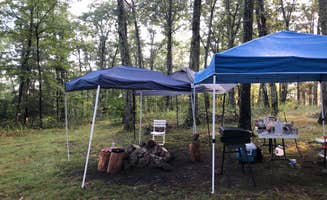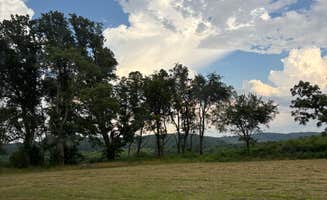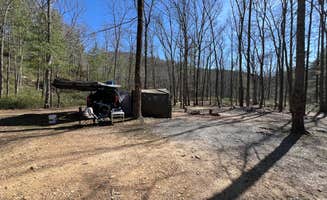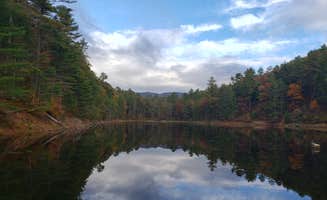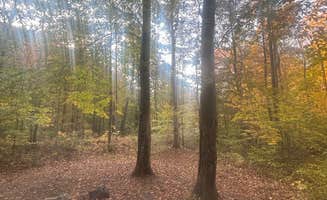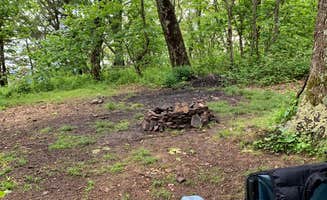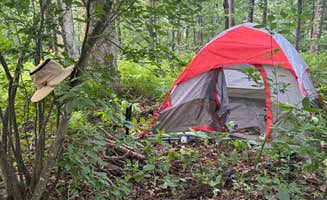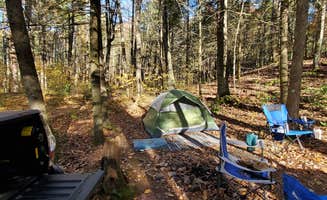Rustic camping near Nellysford, Virginia centers around the eastern slopes of the Blue Ridge Mountains at elevations between 800-3,000 feet. The region's temperate climate makes primitive camping viable from late March through early November, with summer temperatures averaging 10-15°F cooler than surrounding lowlands. Winter camping requires additional preparation as nighttime temperatures can drop below freezing even in fall months.
What to do
Hike to mountain vistas: Access the Appalachian Trail from Forest Road 812, where you'll find multiple dispersed campsites along the way. "There's access to the App Trail on the road so you might see some hikers but it was real quiet otherwise. Pretty nice scenery (you're smack in the middle of the forest) so if you want to get away from people this is a great site," notes a camper at George Washington National Forest off 812.
Creek exploration: Many campsites throughout the area sit adjacent to small streams, perfect for filtering drinking water or cooling off. At Reservoir Road, you'll find "nice camping spots on the pedlar river in Amherst county. Multiple spots along reservoir rd," according to one visitor at Reservoir Road Dispersed Campsite.
Fishing opportunities: Several sites offer access to stocked fishing waters. "The pond is stocked with trout in season, check DGIF site for dates," mentions a camper at Braley Pond. Another adds "the fishing is decent, and we have caught some trout there in the past."
What campers like
Secluded campsites: Most primitive sites in the area offer significant privacy. "I was the only one here on a Saturday night. Very quiet and it was great to have the place to myself. I took advantage of the trails in the morning," reports a visitor at Braley Pond Dispersed Camping & Day Use Area.
Established fire rings: Many dispersed sites come with stone fire rings already in place. At Dispersed Camping Site off FR 812, campers find "a giant fire circle in the middle and enough room to fit about 10 vehicles/groups if people don't mind being next to each other."
Stream-side camping: The sound of running water adds to the camping experience at multiple sites. One camper described their experience: "Nice camping spot in George Washington NF. The spot was nice and flat, backed up to a little creek and had an established stone fire ring."
What you should know
Vehicle requirements: Some sites demand high-clearance vehicles. At Flagpole Knob, "this site requires a 4x4 vehicle with clearance. The trail leading to and from camp can be a bit tricky for some." Another camper warns, "not difficult but definitely need at least a little bit of clearance."
No cell service: Most primitive sites have zero connectivity. A camper at Switzer Lake notes, "Just a heads up, there is no cellphone signal for any carrier from what I could tell." Similarly, at Dispersed Camping Site off FR 812, a visitor reports "No cell service (T-Mobile), but if I drove towards the main road, Route 501, I could get some service."
Permit requirements: Some areas require permits for camping. At James River Wildlife Management Area, you need "to purchase either a daily or annual access pass from the DWR website and then report which days you will be staying at the WMA—it's currently $23 for the annual pass."
Tips for camping with families
Choose sites with flat terrain: Look for established areas with sufficient room. At Switzer Lake Dispersed Camping, "there is a huge variety of spots, starting from huge ones right on the lake to more secluded, smaller spots deeper in the woods along the creek."
Consider day-use amenities: Braley Pond offers extras that can enhance family camping. "I brought my boys out to camp this past weekend, and this place was perfect for our first dispersed campsite experience. The day use area is close enough to use the bathroom (just an open pit toilet, nothing fancy)."
Wildlife awareness: Bears are active in the area. "There are bears here, so lock up your food in the car. We have encountered a bear at or around the campsite 3 times," reports a regular visitor to Switzer Lake Dispersed Camping.
Tips from RVers
Length restrictions: Most dispersed sites accommodate smaller rigs only. At James River Wildlife Management Area - Dispersed Camping, "after turning onto Midway Mills Lane from the northern end (route 626), there is a gravel access road about .5 miles down the road that is well-maintained. It almost immediately opens up into an open field where large rigs of any size can fit."
Road conditions: Road access varies significantly by location. One camper at Reservoir Road noted, "Went in August and it was very buggy, also had someone park pretty close which when I drive down a really long dirt road that is questionable for my van, I want it to be private and this was about 5 miles of dirt road to get to it."
Leveling challenges: Finding flat parking spots can be difficult. A James River WMA visitor shared their experience: "For me being in the 29 foot classy, I opted to park it in a field/parking area at the entrance. I was the only one here all day."


